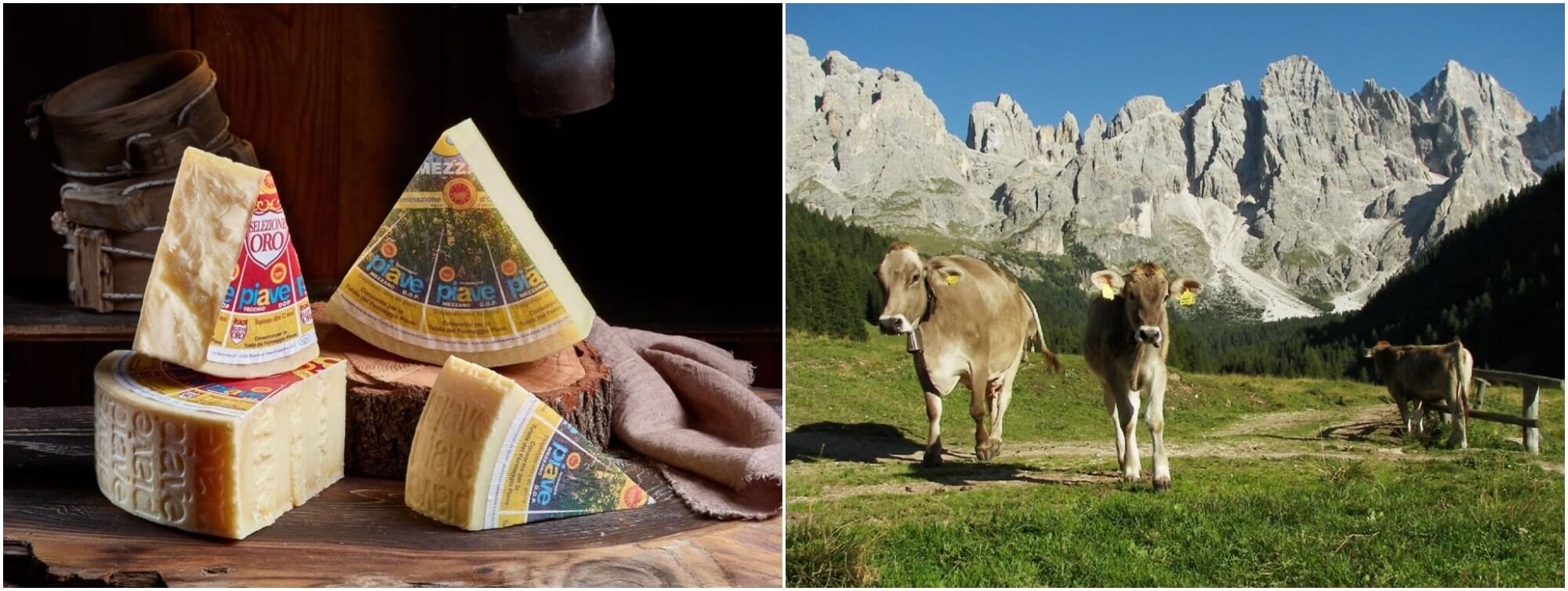Discover PDO Piave A Great Italian Cheese Flying Under the Radar
Even as a cheese writer and educator, Piave wasn’t really on my radar, until it was seemingly everywhere on my radar: one of the blind-tasting cheeses for the Cheesemonger Invitational, mentioned in a Facebook chat among cheese pros as an underrated, best-value cheese, featured in every course in a dinner highlighting Garda wines, and finally, as an opportunity to witness its production firsthand.
Is it Piave’s jaunty, brandished font, or its team of hip, enthusiastic staff that made a whole crew of cheese journalists swoon? (And caused one of them to purchase an entire wheel to take back to Canada?) Or is it just that it’s a really tasty, best-value cheese that sometimes flies under the radar? There’s definitely something about Piave.
Adding to Piave’s obvious quest to make itself known, I now become another vessel for this enigmatic cheese, with a primer on everything you need to know about Piave, starting with: you’re definitely going to want to get some.
Piave PDO
Piave And Cows From Consorzio Tutela Formaggio Piave DOP
Piave is a firm, pasteurized, cooked curd, cow’s milk cheese made from only allowed local breeds: Bruna Italiana, Pezzata Rossa, Frisona Italiana, and Grigio Alpina. (More on its “Alpine” character to come.) One recipe produces 5 variations of different ages: Fresco, Mezzano, Vecchio, Vecchio Selezione Ora, and Vecchio Riserva. (Vecchio is what you are most likely to find in the U.S.)
Despite being made in northeastern Italy’s Belluno region for several generations based on an ancient recipe, Piave is one of Italy’s youngest PDO cheeses, finally achieving its protected designation status in 2010 after a long campaign. “It took 10 years of paperwork,” says Chiara Brandalise, Director of the Piave Cheese Consortium, “can you believe that?” The establishment of the PDO and the furthering education of consumers are the primary objectives of the Consortium, for Piave to gain more international attention for its regional distinctiveness. According to Brandalise, this distinctiveness is very much due to the inoculation of the cheese with specific enzymes taken from local raw milk and whey: “The cheese is the way it is because it is made here in this area and aged here in this area,” she says. According to the Piave DOP website, these enzymes “contain a type of bacterial flora that represents a sort of biological imprint of the geographical area.”
Piave in its modern form is made by mechanical production with exacting criteria, though it is based on local, handmade cheesemaking traditions, with milk collected from a cooperative of local farmers. “The most important thing is to keep the cheese as it was in the past, while maintaining consistent salt and flavor” says Matteo de Battista, Laboratory Specialist at Lattebusche, the sole creamery that makes Piave. Unlike most PDO cheeses which have multiple facilities that make cheese according to PDO standards and regulations, Piave is essentially a monopole, made only at Lattebusche. Curious about the PDO designation? Read more about geographical indication labels found on cheese.
Italian Mountain Cheese Flavor
“Never too strong, always sweet,” Brandalise says of Piave’s flavor, which intensifies with age, and produces a sweet and savory effect consisting of melted butter, tropical fruit, bitter almond, and light vegetal tones.
“Dolomite cheese” may not have the same ring to it as Alpine cheese, but however you prefer it, that’s what Piave is. This mountain range in the corner of northeastern Italy is part of the broader Alps, and cows used in the making of Piave enjoy the same grazing privileges as the cattle that make cheeses such as Gruyère, Emmenthaler, and Comté. This results in cheeses that experience subtle flavor changes between summer and winter based on what the herd is eating, with summer milk cheeses expressing the wildflowers and alliums the cows eat.
Piave in Cooking
As a cooked curd cheese, Piave is an excellent melting cheese, and (per the Piave-in-every-course tasting menu referenced above,) a worthy component in the kitchen. During our visit to the area Piave was served as a foam for a mushroom souffle with crispy prosciutto. Brandalise also suggests the local approach of serving Piave with oven-baked or fried polenta. It would definitely hold its own on cheeseburger, (especially with sweet, deeply caramelized onions,) and it could be used like Gruyère or Raclette melted over potatoes, vegetables, and ham. Why go the Swiss route, though, when you can Piave with Italian flair: hollowed out and used as a vessel to mix risotto.

